Researchers at Georgia Tech have made a significant breakthrough by developing a neural network, RTNet, that can mimic human decision-making processes. This advancement makes AI more reliable and accurate, especially in tasks like recognizing handwritten digits.
Human Decision-Making vs. AI Decision-Making
Humans make about 35,000 decisions each day, from crossing the street to choosing lunch. Each decision involves evaluating options, recalling similar past situations, and feeling confident about the choice. What seems like a quick decision actually involves gathering information from the environment. Interestingly, the same person might make different decisions in identical situations at different times.
In contrast, neural networks traditionally make the same decisions every time. Georgia Tech researchers, led by Associate Professor Dobromir Rahnev, are now training AI to make decisions more like humans. This new approach to machine learning, which is inspired by the science of human decision-making, could make AI systems more dependable.
The RTNet Neural Network
The research team published their findings in the journal Nature Human Behaviour. Their new neural network, RTNet, was trained to make decisions in a manner similar to humans.
Understanding Decision-Making
“Neural networks make decisions without indicating how confident they are,” explained Farshad Rafiei, who completed his Ph.D. in psychology at Georgia Tech. “This is a key difference from human decision-making.”
For example, large language models (LLMs) can sometimes “hallucinate.” When an LLM doesn’t know the answer to a question, it might fabricate one without acknowledging the uncertainty. Humans, however, are more likely to admit they don’t know. Building a neural network that mimics human uncertainty can lead to more accurate and reliable responses.
Training the Model
The researchers trained RTNet using handwritten digits from a well-known dataset called MNIST. They tested the model’s accuracy by adding noise to the digits, making them harder to recognize. The performance of RTNet was then compared to that of humans.
To create RTNet, the team used two main components:
- Bayesian Neural Network (BNN): This type of neural network makes decisions based on probability.
- Evidence Accumulation Process: This process keeps track of evidence for each choice. The BNN’s responses vary slightly each time, and as it gathers more evidence, it can favor different choices. Once enough evidence is gathered, RTNet makes a decision.
The researchers also measured the speed of RTNet’s decision-making to see if it followed the “speed-accuracy trade-off,” a psychological phenomenon where humans are less accurate when making quick decisions.
Comparing AI and Human Performance
Sixty Georgia Tech students viewed the same noisy dataset and recorded their confidence in their decisions. The researchers found that RTNet’s accuracy rate, response time, and confidence patterns were similar to those of the human participants.
“Generally, we lack sufficient human data in computer science literature, so we don’t know how people will behave when exposed to these images,” Rafiei said. “This work provides one of the largest datasets of humans responding to MNIST.”
RTNet not only outperformed other deterministic models but was also more accurate in faster scenarios. This mirrors a fundamental aspect of human psychology: people tend to be more confident when they make correct decisions. Interestingly, RTNet automatically applied this confidence without needing specific training.
“If we try to make our models closer to the human brain, it will reflect in the behavior itself without fine-tuning,” Rafiei noted.
Future Directions
The research team plans to train RTNet on more varied datasets to explore its potential further. They also aim to apply the BNN model to other neural networks, enabling them to think more like humans. Eventually, AI might not only mimic our decision-making abilities but also help reduce the cognitive load of the 35,000 decisions we make daily.
Conclusion
This development in AI, where neural networks like RTNet can think more like humans, is a game-changer in machine learning. By incorporating human-like decision-making processes, AI systems can become more reliable and accurate. This breakthrough opens up new possibilities for AI applications, making them more effective in real-world tasks.
Reference
“The neural network RTNet exhibits the signatures of human perceptual decision-making” by Farshad Rafiei, Medha Shekhar, and Dobromir Rahnev, published on 12 July 2024 in Nature Human Behaviour.
